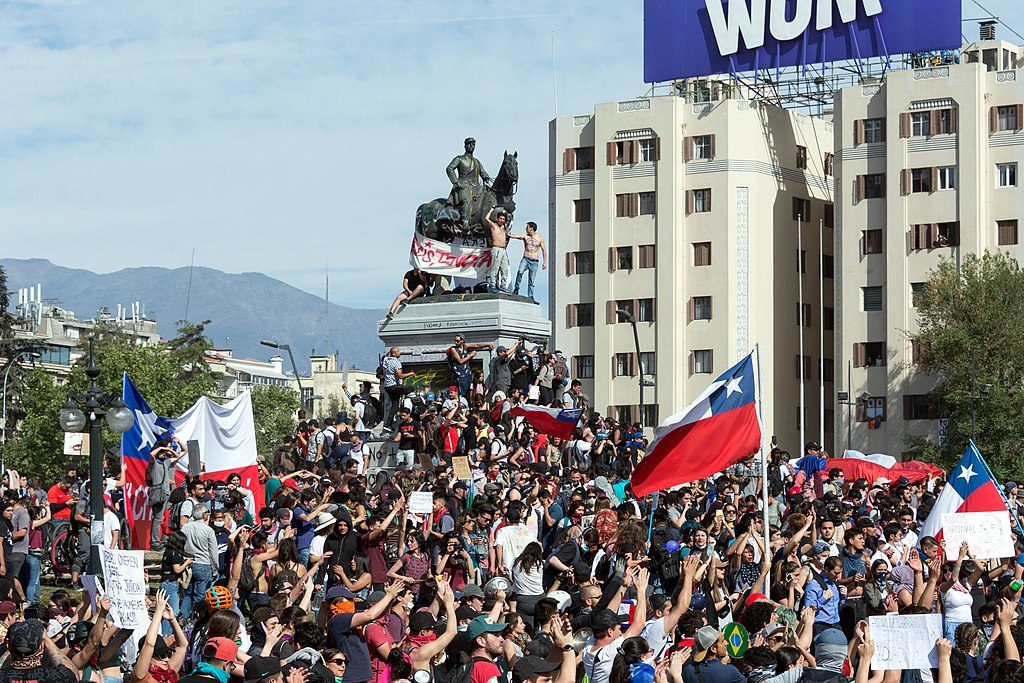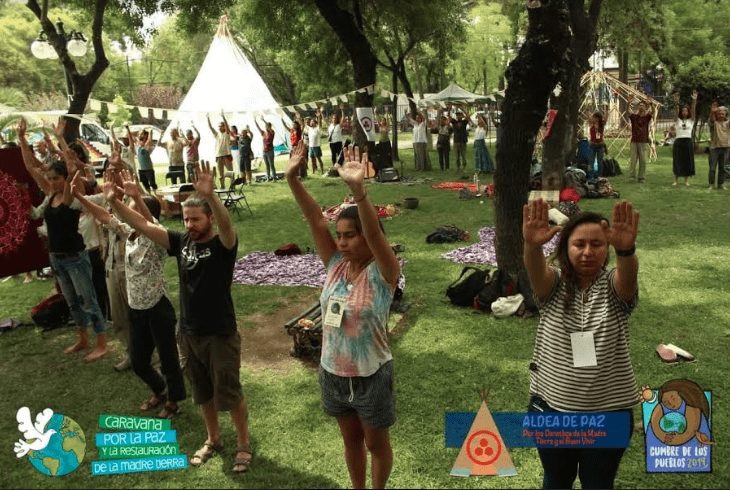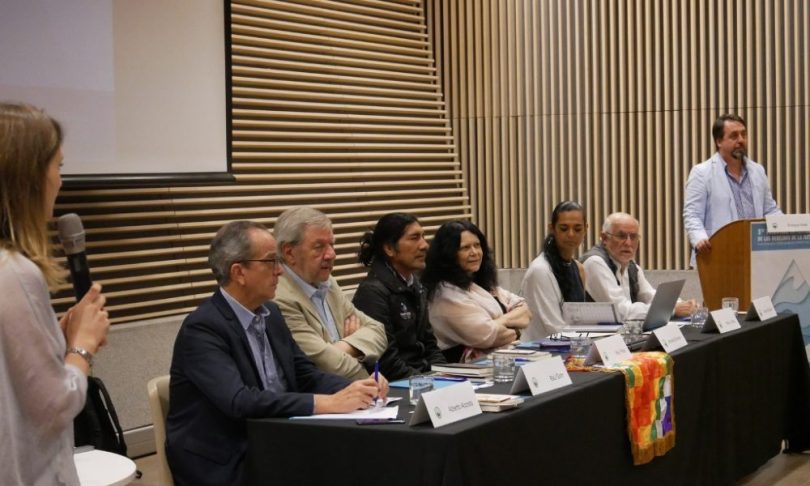
Within the framework of the protests, massive marches, peaceful and violent mobilizations, the brutal police and military repression of the governments of Ecuador, Bolivia and Chile that have been taking place in Latin America since October, preparations were coming together for COP-25 (COP, or Conferences of the Parties, UN Assembly for Climate Change), scheduled to be held in Santiago de Chile in the first week of December.
However, the formidable and unexpected escalation of opposition to the government of Sebastián Piñera forced him to cancel his commitment, and quickly find an alternative venue, which turned out to be Madrid. Simultaneously and parallel to the meetings of the COPs, since 2005 a series of meetings of organizations and social and environmental movements have convened in the same city as the COP, called the People’s Summits, questioning the decisions made at these meetings of world governments.

The displacement of the COP-25 to Spain did not prevent a trio of alternate activites aimed at generating true solutions to the climate crisis: the Peoples’ Summit, the International Rights of Nature Tribunal and the assembly of a Peace Village from being held in Santiago, Chile.
Since 2018, a political coalition was emerging in Chile, arising as an alternative to the duopoly formed by traditional rights and lefts, convened by a Broad Front of organizations throughout the country, to which emerging networks of change were added, with the proposal to contribute a new element to the alternative Summit: the assembly of a Peace Village, which seeks to transcend the justified protests, offering programs and activities that manifest options for the construction of an ecological, participatory, nonviolent, solidary, free and creative society.
The design of a temporary Peace Village was inspired by the artivists of different global movements as an experimental educational space that offers knowledge, practices and tools for living in harmony with Nature, thereby generating a culture of peace. Since 1996, promoted by the Rainbow Peace Caravan, Peace Villages have been taking shape in different countries such as Mexico, Ecuador, Peru, Brazil, Argentina, and Chile, and are currently being replicated with their own characteristics in each territory where they arise.
So from Dec. 2-7, on the campus of the University of Santiago de Chile (USACH), the Peoples’ Summit and the Peace Village were held in Santiago, Chile, allowing the collaboration between civil society, academia, organizations and networks, environmentalists, pacifists, jurists, activists, artists, indigenous leaders, spiritual guides, representatives of communes and neighborhoods and citizens who are working for the care of Nature and the guardianship of the territories.
Between Monday, Dec. 2 and Friday, Dec. 6, in the beautiful space of the Village of Peace in the gardens of the USACH, under a dozen tipis, bamboo domes, geodesics, tents, colorful canvases, flags of Tibet, of world peace, of rainbows and the colorful checkered Andean wiphala, several hundred people had the opportunity to participate in the multiple and diverse activities programmed by the convening team and coordinator of the meeting, as well as the organizations that supported its realization.

The program included ceremonies, ecological workshops such as construction of bamboo structures, urban gardens, vertical and roof gardens, and permaculture; of natural nutrition, plants, yoga and integral health; circles of chanupa and Elders’ Councils; of Young Latin Americans for Nature; children’s workshops, eco-schools, children’s assembly; of personal and group growth, neighborhoods and villages in transition, circular dances of universal peace, Mayan Synchronization, community empowerment, theater, acrobatics, circus, Kirtan and musical concerts.
All these activities had a biocentric approach, emphasizing the importance of understanding that all these projects and purposes for our common good, still do not include the one that allows us to survive, human and non-human, which is our common Mother, the Pachamama or Mother Nature.
We do what we do in order to have more holistic health, a more conscious education, a more organic diet, a more integral personal and collective development, respect for all our human relationships, with children, young people, grandfathers and grandmothers, for having a more creative and artistic life, a more just, free society, respectful of cultural and natural biodiversity, increasingly inclusive human rights. All those achievements and steps are and will always continue depending on the health of that, our only Mother Earth.
And as long as we fail to make an evolutionary leap of consciousness to recognize, adopt, defend, make her own legal rights binding, we will continue to use her, violate her, exploit her, vandalize her to the point of no return, endangering our own survival as a species.

Within the framework of both the Summit and the Village, the Fifth International Rights of Nature Tribunal took place with the participation of invited experts from the global movement for the Rights of Mother Earth.
The increasingly global movement for the Rights of Mother Earth/Mother Nature had its beginnings at the legal level in Ecuador in 2008, as a result of the interaction of the environmental, social and indigenous guardians of the ancestral worldview of the Sumak Kawsay or Buen Vivir/Good Living, with the emerging movement of Latin American Constitutionalists, who managed to incorporate these rights into the Montecristi Constitution.
From that first step, the Plurinational State of Bolivia amended its Political Constitution in 2009, taking a year later to the General Assembly of the United Nations a proposal for a Universal Declaration of the Rights of Mother Earth, which is currently being disseminated all over the world.
In this decade dozens of local, state, national and international actions are being carried out for the recognition of rivers, lakes, glaciers, jungles, territories as living, sentient, sacred entities, sanctuaries of natural and cultural biodiversity in many cultures, with their own legal rights.
Even if these rights have already been approved in articles of their respective Constitutions, they still do not have binding status, that is, there is no Office for the Defense of Mother Earth, no competent courts or repercussions for those who violate them. Therefore, since 2014, the International Courts for the Rights of Nature have been carried out within the framework of the last COPs.
These Courts have met in Quito, Lima, Cochabamba, Paris and Bonn, chaired by world-renowned personalities such as Vandana Shiva, gathering prosecutors, case presenters, experts, people affected by each of the Ecocides or violations and with a jury to pass sentences on the transnational mining, logging, oil, fracking, mega-hydroelectric companies and governments involved.
Such cases include severe affectations or privatization of water sources, rivers, lakes, basins, seas and all living beings inhabiting these ecosystems, forests, jungles, deserts, mountain ranges, subsoils, air, reefs, National Parks, but also to local populations, to defenders of indigenous territories and communities, in North, Central and South America; the United States, Africa, Asia, Australia, Europe, as well as the main causes of climate change, fire and the loss of natural and cultural biodiversity of the entire Earth.
The most recent International Court took place on Dec. 5, 2019, in its fifth edition in the city of Santiago de Chile. The Faculty of Physical and Mathematical Sciences of the University of Chile hosted the Tribunal, whose judges were: Yaku Pérez (president of the Tribunal-Ecuador), Maristella Svampa (Argentina), Raúl Sohr (Chile), Antonio Elizalde (Chile), Alberto Acosta (Ecuador), Nancy Yáñez (Chile); the Prosecutor for the Earth was Enrique Viale (Argentina) and the secretary of the Court, Natalia Greene (Ecuador). Approximately 150 people listened to the judges, presenters, experts and people affected throughout the intense day.

The cases that were tried were: 1) Lithium mining in the Atacama Desert – Chile, 2) Threats to Patagonia: water and life reserve – Chile, and 3) Water privatization: water as an object in Chile. Additionally, two cases were considered for admissibility: Amazon (several countries) and Vaca Muerta (Argentina).
As in all previous Courts, although the judges issued preliminary verdicts for each case, the final verdicts were subsequently announced, once all the evidence presented was integrated. The sentences that arise from these verdicts will not be binding, so we are talking about Ethical Courts, but in addition to giving media visibility to each of the Ecocide cases, and recognizing those guilty of them, they set a precedent for what will be achieved sooner or later, locally, nationally and internationally, to stop and punish the abuses that the extractive paradigm of savage global neoliberalism are causing throughout Mother Earth.
Simultaneously, within the framework of the COP25 in Madrid, a workshop was held with Amazonian people to talk about the Rights of Nature and testimonies began to be gathered for the case of the Amazon River, in all the countries that it crosses, which will be presented in the next court.
The Peoples’ Summit in its final declaration condemned the government as well as the repressive military and police institutions, and it “endorsed and supported each of the social demands for the recovery of water, copper and mining resources, in defense of the Mother Earth, for the rights of workers, women, the elderly and children, for a fair chance, for human, economic, social and cultural rights, making essential the role of citizens as a PRIMARY CONSTITUENT POWER, and the call to a Constituent Assembly that generates a Political Constitution truly representative of national and popular sovereignty.”
For its part, the Peace Village, in its final statement, shared these messages:
“This is the path we must follow to take responsibility for practicing and transmitting a “care of life ethic” as a way of living and being part of the paradise that is Mother Earth, the Pachamama, the Ñuke Mapu, as a passport to enter the good life. In this way, we will see that the beautiful biodiversity that surrounds us starts from an essential principle unique and united to the whole.
We are human beings who understand that our ancestral wisdom, anchored in our original nations, sustains and maintains us and it is our duty to protect and love it.
We understand the need to incorporate the rights of nature, and of all living beings that sustain the planetary fabric, as constituents of our lives and the laws of the peoples.
Rivers have the right to live in peace, bees and animals are subject to law. We also understand that it is our natural right to live in peace between humans and with all beings. And so we will enter it in our codes.
We declare absolute dependence on the forces of the spirit that animates all that is. We also understand the vital interrelation with the beings of all the kingdoms that live in our common house …
We celebrate that this moment has finally arrived and, consequently, WE DECREE the Southern Cone of Abya Yala as a reserve of the ECOSPHERE, for the common good of our present and future generations. And so we enforce it in our homes, communities and territories.”
Among the participants in the Peace Village:
The Vision Council of Chile
The Chilean Movement for Rights of Mother Earth
Latin American Alliance for the Rights of Mother Earth
Biokismos-Biocultura 2013-2020
C.A.S.A., Council of Sustainable Settlements of Latin America
C.A.S.A. Chile
La Bella Ecovillage
Roerick de la Paz Flag Foundation
Permaculture and Transition Institute
Caravan for Peace and Restoration of Mother Earth
Casa Putraintu
Hostal Onai
Somos Paz
Colectivo Hebras de la Memoria (Threads of Memory Collective)
Organizacion Basura0-Chile (Zero-Waste Chile)
Cultivo Forraje Hidroponicos y Jardines Verticales (Hydroponic Forage and Vertical Gardens)
Fundacion Weychoyen
Red de Semillas Libres (Free Seed Network)
Derechos de la Madre Tierra Chile
Krishna Community
Corporacion CODEFF
Fundacion del Tiempo/Sincronario Maya
Sangha de Danzas de la Paz Universal
Humitos Sagrados
Ecoescuela Transisol; also a number of volunteers who offered healing therapies, sahumadoras (incense bearers), Dancers for Universal Peace, musicians, etc.
Coyote Alberto Ruz is a first-line pioneer, veteran and historian from the intentional communities, ecovillage and bioregionalist movements. In the last seven years he has dedicated most of his time to organizing global, local and national campaigns for the Rights of Mother Earth.
COP25 International Rights of Nature Tribunal Peace Village and Rights of Nature Caravan People's Summit Rights of Mother Earth Santiago de Chile